THEBES
RAMESSES III
THE LAST GREAT PHAROAH

|
Small Temple of Ramesses III at Karnak.
This photo depicts the colonnade of broken osiriform statues found on the
east side of the forecourt. The statues represent Ramesses III (ca. 1182
B.C.) standing erect as the god Osiris, with arms crossed and holding the
crook and flail. Ramesses III built this small temple in the First Court
of the great temple of Amun at Karnak. It functioned as a way-station for
the portable barks and statues of Amun, Mut and Khonsu when carried in
procession. The white stains on the legs of the statues are the efflorescence
of salts resulting from high levels of moisture and groundwater in the modern
environment
Photo taken
by Tom Van Eynde |

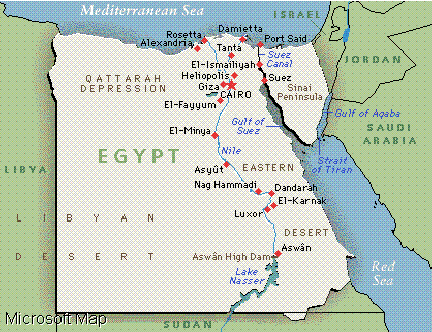 |
EGYPT AND THE SINAI: Egypt, officially known as the
Arab Republic of Egypt, is located in northeastern Africa and includes in
its domain the Sinai Peninsula. Egypt is bound on the north by the Mediterranean
Sea, on the east by Israel and the Red Sea, on the south by the Sudan, and
on the west by Libya. Cairo is the capital and largest city. The land of
the Nile River, Egypt is the cradle of one of the world's greatest ancient
civilizations and has a recorded history that dates from about 3200 BC. |
The City Of Thebes
A capital of ancient Egypt, Thebes rose in importance as the home of several
royal families from the 11th dynasty (established c.2133 BC). Kings of the
12th dynasty lived near Memphis but honored the Theban god Amon, and under
the 17th and 18th dynasties Thebes became the capital of the Egyptian empire.
Kings of the 19th and 20th dynasties lived in the north but lavished attention
on Thebes. As the empire began to decline (c.1200 BC), Thebes was controlled
by militaristic high priests; in 661 the city was sacked by the Assyrians.
Thebes continued to be an important center during Ptolemaic times (304-30
BC), but it declined thereafter and now consists of the villages of Luxor
and Karnak. Some Theban monuments are very well preserved. On the east bank
of the Nile the principal ancient town site is covered by modern settlements,
but two great temple complexes remain. Amon's temple at Karnak is the larger,
covering more than 54 ha (133 acres) and representing almost 2,000 years
of building activity (from 2000 BC). The other temple, at LUXOR, was begun
in 1417 BC. On the west bank are tombs of 11th- and 17th- to 20th-dynasty
royalty. The New Kingdom burial grounds are in the remote valley where
TUTANKHAMEN's tomb was found. Several large royal funerary temples survive
at the edge of the river, and the desert foothills are filled with tombs
of nobles who lived during the New Kingdom and later. Many of the temples
are decorated with paintings that are masterpieces of Egyptian art. Several
west-bank towns were important, particularly the palace-city of Amenhotep
III at Malkata and the town of Medinet Habu
For two thousand years Egyptian civilisation had been pre-eminent, indeed,
Egypt had enjoyed a prestige throughout the know world second to none. By
the time of Rameses III, however, the world was going through great upheavals.
That long period of stability in the Middle East brought about by Thutmose
III and continued by Rameses II's treaties with the Hittites was about to
come to an end. This was the time of the Trojan Wars and the fall of Mycenae.
A time when age-old empires were weakened by complacent rulers and failed
harvests.
It is recorded in the longest know papyrus, the Great Harris Papyrus, that
many people throughout the region were made homeless. 'The foreign countries
plotted on their Islands and the people were scattered by battle all at one
time and no land could stand before their arms.' This great movement of people
was well armed and desperate. Known as the Sea Peoples, they obliterated
the Hittite Empire and for a while threatened Egypt with extinction also.
But Egypt was not about to give up and sink into oblivion, not yet anyway.
There was still one more moment of glory for these most ancient of ancients.

RAMESSES III
(Usermaatremeryamun)
1184-1153 B.C.
20th Dynasty
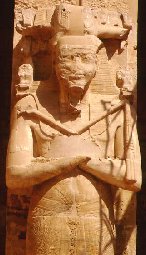
|
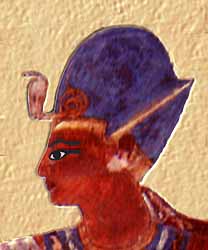
|
RAMESSES III
AS OSIRIS |
A Tomb Image |
Ramesses III (20th Dynasty)
1184 - 1153 BCE (British Museum)
1194 - 1163 BCE (Baines and Málek)
1186 - 1154 BCE (Grimal)
1182 - 1151 BCE (Gardiner)
Birth Name: Ramesses heqaiunu
("Re Has Fashioned Him, Ruler of Heliopolis")
Throne Name: User-Maat-Re Mery-Amun
("Powerful is the Justice of Re, Beloved of Amun")
Ramesses III became the second ruler of the 20th Dynasty immediately following
the death of Sethnakhte, his father, who ruled for a short two year reign.
Though not related, he sought to mirror the actions of Ramesses II, even
choosing a similar titulary. He modeled his own mortuary temple on the Ramesseum
and in like manner glorified himself with depictions of great war victories
on his monuments. He also ran trade expeditions to Punt. An important historical
document of his reign is the famous Papyrus Harris I. This not only lists
his benefits to the temples of Egypt's major gods, but gives a summary of
the events leading up to his reign as well as his own acts in war and peace.
Ramesses III started his rule with Egypt in ruins and in a very short time
became the richest King of all.
The treasures of Solomon's Temple were handed over to the Egyptian King Shishak.
The site in the Judean hills is a ruin which we believe is an Egyptian Temple
built by Ramesses III as described in the Harris Papyrus.
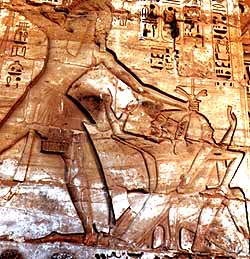
Ramesses fought the Libyans twice during his reign. He compared himself to
Mont, the god of war and was confident in his abilities. He overcame an
attack by
the Sea Peoples in his eighth year as pharaoh. After defeating the Sea
People (of which he took many captives) he attacked the Palestinian tribes
and was again victorious.
Ramesses received tributes from all conquered peoples. Egypt, however, was
experiencing financial problems. Workers were striking for pay and there
was a general unrest of all social classes. Consequently, an unsuccessful
harem revolt led to the deaths of many, including officials and women.
Rameses IIIís death marks the end of an era. He had ruled for 31 years and
was the last of the great Pharaohs. Egypt now began to suffer economic problems
and was unable to exploit the revolution of the Iron Age (This began around
1200 BC) because she had no sources of ore.
During his thirty-one year reign, Ramesses built the vast mortuary complex
at Medinet Habu, three shrines at Karnak that were dedicated to the gods
Amon, Mut and Khons, and a palace at Leontopolis, just north of Cairo. Ramesses
III's tomb is in the Valley of the Kings. His mummy was found in a cache
at Deir el-Bahri and is now in the Cairo Museum. Ramesses III is thought
to have been about sixty-five years of age at his death.
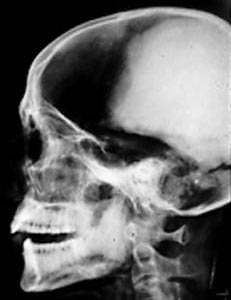
|
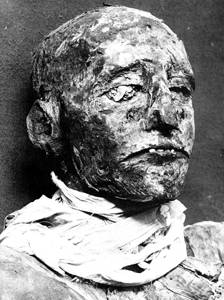
|
An X-ray of Ramesses III,
in the Cairo Museum. |
The Mummy of Ramesses III,
in the Cairo Museum. |
Ramesses III outlived several of his offspring, and buried a number of them
in the Valley of the Queens along with his queens. Ramesses III himself was
buried in KV 11, a tomb that was begun by his father Sethnakhte before abandoning
it to use KV 14. His mummy was rewrapped by 21st Dynasty priests of Amun,
moved to the Deir el Bahari cache, and discovered in 1881. The mummy is
remarkably well preserved and not damaged at all by tomb robbers.

|
The tomb is sometimes referred to as the "Harpers Tomb" due
to the two harpers playing to the gods in four of the chambers.
Ten small chambers branch off of the main corridors.
These were for the placement of tomb furniture. |
During the first few years of his reign, Rameses III consolidated the work
of his father, Setnakhte, by bringing unity to the country. Therefore, in
his fifth year when the Libyans attacked, Egypt was well prepared. It had
been twenty-seven years since Merenptah had repulsed their last offensive,
now again, an organized and efficient Egyptian army easily defeated them.
But this was nothing compared to the second and much greater threat, which
came three years later.
The Sea Peoples
were on the move. They had, by now, desolated much of the Late Bronze Age
civilizations and were ready to make a move on Egypt. A vast horde was marching
south with a huge fleet at sea supporting the progress on land.
To counter this threat Rameses acted quickly. He established a defensive
line in Southern Palestine and requisitioned every available ship to secure
the mouth of the Nile. Dispatches were sent to frontier posts with orders
to stand firm until the main army could be brought into action.
The conventional
chronology dates this event of the Sea Peoples defeated in year 8 of Ramesses
III. to 1190BC.
RAMESSES III - SHISHAK - MERNEPTAH
- SESI |
SHISHAK - IS THIS THE SAME
PERSON?
Egyptian chronology in this period is dated by a biblical synchronism, that
of Pharaoh Shishak's attack on Judah in the fifth year of Rehoboam (c.925
BC - see I Kings 14:25, II Chronicles 12:2). Shishak is normally identified
as Shoshenq I, founder of the XXIInd dynasty, and is in some ways a likely
candidate. But, in view of the desirability of shortening all the dark ages,
James suggests that Shishak was actually Ramesses III (normally dated c.1200
- 1165 BC), thereby removing about two and a half centuries from the dark
ages. Ramesses III was nicknamed Sesi which was perhaps imperfectly
transliterated as Shishak. |
MERNEPTAH - IS THIS THE SAME PERSON?
The steep descent into the tomb is typical of the designs of the XIX Dynasty.
The entrance is decorated with Isis and Nephthys worshipping the solar disc.
Text from the Book of the Gates line the corridors. The outer granite lid
of the sarcophagus is located in the antechamber, while the lid of the inner
sarcophagus is located down more steps in the pillared hall. Carved on the
pink granite lid is the figure of Merneptah as Osiris. |
There were clearly two waves of
migrating
Sea Peoples: the first arriving circa 1200 B.C., after Pharaoh Ramesses
II but before Ramesses III, and using locally made Mycenaean IIIC:1b pottery;
and the second wave during the days of Ramesses III and using the classic
Philistine pottery.
WHO WERE THE
PHILLISTINES?
It is also interesting to note here that the Philistines are not listed with
the pre-Israelite nations in Canaan in Abraham's time (Gen. 15:19-21). If
the text reflects a tradition that goes back to the Mosaic period, this is
logical to expect, since the Philistines were not "settled" by Pharaoh Ramesses
III on the coast of southern Canaan before the time of Moses.
Therefore, if the Caphtorim were the ancestors of the Philistines (Stiebing
1980, 14) and the Philistines of Medinet Habu did not arrive in Canaan before
the time of Ramesses III, then Deuteronomy 2:23 may also give us an approximate
time for the coming of the Philistines into Canaan. There, Moses reviews
the chronology of events after leaving Egypt and states, "As for the Avvim,
who had lived in settlements in the vicinity of Gaza, the Caphtorim, who
came from Caphtor, destroyed them and settled in their place." Moses does
not use the term Philistines, though Joshua does. |
The clash, when it came was a complete success for the Egyptians. The Sea
Peoples, on land, were defeated and scattered but their navy continued towards
the eastern Nile delta. Their aim now, was to defeat the Egyptian navy and
force an entry up the river. Although the Egyptians had a reputation as poor
seamen they fought with the tenacity of those defending their homes. Rameses
had lined the shores with ranks of archers who kept up continuous volleys
of arrows into the enemy ships when they attempted to land. Then the Egyptian
navy attacked using grappling hooks to haul in the enemy ships. In the brutal
hand to hand fighting which ensued the Sea People are utterly defeated.
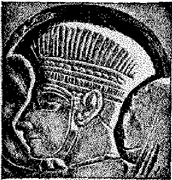 |
Philistine Head Dress
from Medinet Habu |
The power of the
Sea Peoples
was broken in the Nile delta but some, the biblical Philistines, settled
in Palestine. With the exception of one more conflict with the Libyans, the
rest of Rameses IIIís long reign was peaceful. Trading contacts were revived
with the Land of Punt, law and order was reestablished throughout the country.
There was a major program of tree planting and building, the finest example
of which is the temple at Medinet Habu.
A CONNECTION
TO KING DAVID ?
The final Canaanite stratum, stratum IX (1200-1150 B.C.), was destroyed in
the mid-twelfth century B.C. This stratum contained no Mycenaean or Cypriot
imports, the same finding that we observed at other nearby sites, but neither
did stratum IX contain Philistine sherds. Philistine pottery did not appear
until the following stratum, stratum VIII. Oren believes that the Philistine
pottery did not appear before the end of the reign of Pharaoh Ramesses III
in the mid-twelfth century B.C. (Oren 1982, 166). He also believes that the
destruction of stratum IX may have been due to a group of the Sea Peoples
or possibly the Amalekites (mentioned in 1 Sam. 30).
The eleventh-century B.C. buildings of stratum VIII contained late Philistine
pottery of various types, such as common bell-shaped bowls, beer jugs, and
Ashdod ware, a type of pottery that is decorated by applying black and white
over a red background. Oren emphasizes that there is continuity without a
destruction layer between the Philistine stratum VIII and the following Israelite
stratum VII, which would be logical if Tel Sera` were David's Ziklag. There
would have been no reason for David to destroy this town before moving to
Hebron to become the king of Judah; ". . . therefore Ziklag has belonged
to the kings of Judah to this day" (1 Sam. 27:6). |
Rameses III had two principle wives plus a number of minor wives and it was
one of these minor wives, Tiye, who was the cause of his destruction. She
hatched a plot to kill him with the aim of placing her son, prince Pentaweret,
on the throne. She and her confederates stirred up a rebellion and used magic
wax images and poison as their weapons. The conspiracy failed and the traitors
were arrested but not before Rameses was mortally wounded. Fourteen officials
sat in judgment and all the accused, with the exception one, was found guilty
and condemned to commit suicide. Rameses died before the trial was completed.
Ramesses IV
(Hekamaatresetepenamun)
1153-1147 B.C.
20th Dynasty
Ramesses IV was the son of Ramesses III. His reign lasted no more than six
years. He did survive the harem conspiracy which was designed to spoil his
claims to the throne. He placed a document in the tomb of his father which
is now known as the Papyrus Harris I, that gives an elaborate account of
the reign of Ramesses III. Ramesses IV is thought to have been in his forties
when he became king.

MORTUARY TEMPLE OF RAMESSES III
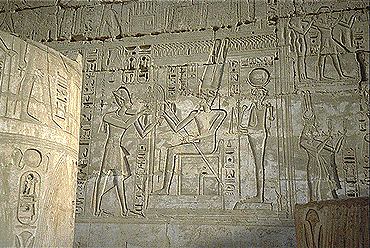
THE TOMB OF RAMESSES
III - (MAP OF TOMB)
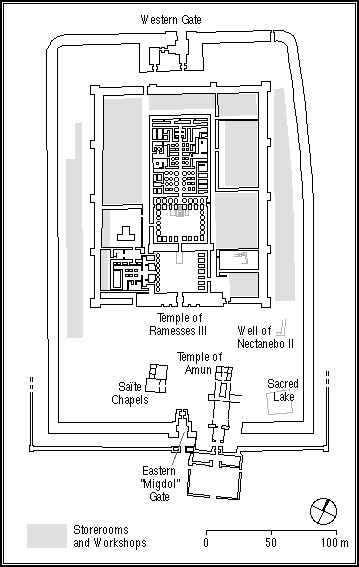
MEDINET HABU
ANOTHER PLAN MAP AND PHOTOS
Rameses IIIís death marks the end of an era. He had ruled for 31 years and
was the last of the great Pharaohs. Egypt now began to suffer economic problems
and was unable to exploit the revolution of the Iron Age (This began around
1200 BC) because she had no sources of ore. But the most important factor
in Egyptís decline was a break down in the fabric of society. There were
disputes between officials and governors and infighting between the north
and south. The priesthood became over powerful and eventually they took control
of the government. From this time onwards others would determine the destiny
of the Mediterranean world. The Assyrians, Persians, Greeks and eventually
the Romans were to become the lead players on the stage of international
politics.

THE TEMPLE AT KARNAK
For the largely uneducated ancient Egyptian population this could only have
been the place of the gods. It is the mother of all religious buildings,
the largest ever made and a place of pilgrimage for nearly 4,000 years. Although
todays pilgrims are mainly tourists. It covers about 200 acres 1.5km by 0.8km
The area of the sacred enclosure of Amon alone is 61 acres and would hold
ten average European cathedrals.The great temple at the heart of Karnak is
so big, St Peter's, Milan and Notre Dame Cathedrals could be lost within
its walls. The Hypostyle hall at 54,000 square feet with its 134 columns
is still the largest room of any religious building in the world. In addition
to the main sanctuary there are several smaller temples and a vast sacred
lake.
Karnak is the home of the god Amon who was an insignificant local god until
the 12th dynasty when Thebes became the capital of Egypt. He was represented
in his original state as a goose and later as a ram, at the height of his
power he was shown as a human with a head dress of feathers - all that remained
of the goose.
In ancent times wars were not fought between countries but were considered
as contests between gods. One deity subduing and replacing another, the
victorious god and its people growing in strength. This is how Amon, with
the help of Thutmose III and various other New Kingdom kings, rose to become
the first supreme god of the known world and was hailed as God of gods. Little
is know of him, unlike most other gods he has no legends or miracles to impress
his worshippers and seems to be closer to an abstract idea of a godhead.
His followers came from all the strata of society and he was known to some
as 'Vizier of the poor.'
All Egyptian temples had a sacred lake, Karnak's is the largest. It was used
during festivals when images of the gods would sail across it on golden barges.
Karnak was also the home of a flock of geese dedicated to Amon.
The Eastern Gateway which once lead to a huge temple built by Akhenaten (the
heretic king). In an attempt to obliterate his memory, Akenaten's enemies
destroyed this shrine after his death.
THE SACRED LAKE
The lake is 129 X 77 meters and was used for ritual navigation. It was surrounded
by storerooms and living quarters for the priests. There was also an aviary
for aquatic birds.
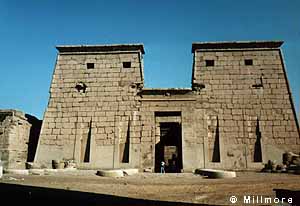
Temple of the Theban moon god Khonsu - son of Amon and Mut. He is often
represented as a human headed figure wearing a crescent and disk.
The temple was built by Ramses III.
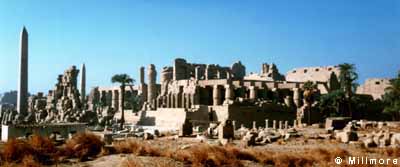
THE TEMPLE OF AMUN - THE GREAT
COURT
THE TEMPLE OF AMON - RA

HYPOSTYLE HALL AT KARNAK
The massive columns in the hypostyle hall dwarf the people.
photo by Tom
Van Eynde
Temple of Ramesses III at
Medinet Habu
The entire Temple of Ramesses III, palace and town is enclosed within a defensive
wall. Entry is through the Highgate, or Migdol, which, in appearance resembles
an Asiatic fort. Just inside the Highgate, to the south, are the chapels
of Amenirdis I, Shepenwepet II and Nitoket, wives of the god Amun. To the
north side is the chapel of Amun. These chapels were a later addition dating
to the 18th Dynasties, by Hatsepsut and Tutmose II. Later renovations were
done by the Ptolemaic kings of the XXV Dynasty.
To the west is the temple proper, which was styled after the Ramesseum. On
the north wall of the temple are reliefs depicting the victory of Ramesses
with the Sardinians, Cretans, Philistines and the Danu. This was perhaps
the greatest victory in ancient Egypt. Pharaoh watched as the invaders crossed
the plains, destroying everything in their path. The multitude came with
oxen-drawn wagons, laden down with all of their possessions, their families
and their newly discovered iron weapons. No tribe or settlement was able
to survive their passing. The horde came over the land and the sea heading
straight for Egypt. Ramesses gathered together his army and defeated the
land invaders. He then proceeded to the shore to meet the ships. Ramesses
archers released their arrows against the landing ships. (The Egyptians's
had an advantage over the enemy; the Egyptian's ships had both sails and
oars, while the invader's had only the sail.) The Egyptian army then rowed
out to sea and overturned the invaders' ship, drowning all that survived
the archers' attack. These are the only know reliefs of a sea battle in Egypt.
The Egyptians were excellent accountants and counted everything that was
taken from the enemy and all that were slain. The reliefs show the bookkeepers
counting the spoils. Entering through the massive Pylon (27m high and 65m
long) is the First Court where athletic sporting events, such as wrestling,
were held. Reliefs on the south wall are of Ramesses' victory over the Libyans
and the Window of Appearances is on the west wall, flanked by eight columns.
Behind this lies the audience hall with the kings' shower room nearby. The
stone tank is still intact. On the east side are seven Osiride pillars.
The Second Court,
accessed via ramp up and through the Pylon, is made up of eight Osiride pillars
and six columns. Of the scenes in the Second Court are the Feast of Sokar
and the lower part of the back wall being dedicated to Ramesses children.
Of interest in the entrance at the right end of the hall is a relief of Ramesses
kneeling on the symbol of Upper and Lower Egypt and a defaced scene of Ramesses
before Seth, with the Pharaoh changed into Horus. The Hypostyle Hall through
the west entrance was badly damaged in 27 B.C. by an earthquake. Originally,
The Hall would have opened into many rooms but none remain due to the earthquake.
Close to the temple is the remains of a Nilometer. These 'flood warnings'
were positioned strategically along the river to determine the position of
the river every year. Not only did these register the height of the river,
but also determined the amount of silt that was being deposited. With this
information, the governors could, in advance, determine which crop would
thrive and thus base the tax levy.
THE KINGS OF THE 20TH DYNASTY
SETAKHT
RAMESSES IV -
RAMESSES IV
RAMESSES V
RAMESSES VI -
RAMESSES VI
RAMESSES VII
RAMESSES VIII
RAMESSES IX
RAMESSES X
RAMESSES XI
OTHER EGYPTIAN LINKS
THE TOMBS OF THE RAMESSES
PHAROAHS AT THEBES
THE TOMBS OF THE KINGS
THE RAMESSEUM
EGYPTIAN KINGS
THE PHAROAHS
OF EGYPT
THE CHRONOLOGY OF THE
KINGS
A BIBLICAL
CHRONOLOGY OF TIME AND DISASTERS
THE TWENTY SECOND DYNASTY - A
HISTORY
NEW
KINGDOM HISTORY
A BIBLICAL COMPARISON OF NAMES
TO THE PHAROAHS
AN
EPIGRAPHIC SURVEY OF THE TEMPLE TOMBS
TEMPLE OF KHONSU
THE TOMB AT LUXOR
TEMPLE OF MUT
THE EGYPTIAN ROYAL TOMBS OF THE
NEW KINGDOM
GUARDIAN'S EGYPT - EGYPTIAN
SITES AND MONUMENTS
A LISTING OF THUMBNAIL
PHOTOS OF THE TOMBS AND EGYPT
THUMBNAIL PHOTOS
OF THE TOMBS AND EGYPT
THE VALLEY OF THE KINGS
THE LUXOR AREA
THE HISTORY
OF ANCIENT EGYPT
OTHER
PEOPLE OF INTEREST
QURAN REFERENCES
TO THE PHAROAH
TO GREATDREAMS- MAIN INDEX
If you have any questions or comments about this page, or would like to suggest
a link, please e-mail Dee777@aol.com
TO MAIN INDEX
















